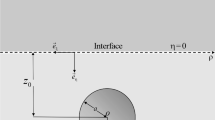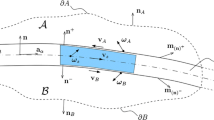Abstract
The motion of a spherical particle in infinite linear flow and near a plane wall, subject to the slip boundary condition on both the particle surface and the wall, is studied in the limit of zero Reynolds number. In the case of infinite flow, an exact solution is derived using the singularity representation, and analytical expressions for the force, torque, and stresslet are derived in terms of slip coefficients generalizing the Stokes–Basset–Einstein law. The slip velocity reduces the drag force, torque, and the effective viscosity of a dilute suspension. In the case of wall-bounded flow, advantage is taken of the axial symmetry of the boundaries of the flow with respect to the axis that is normal to the wall and passes through the particle center to formulate the problem in terms of a system of one-dimensional integral equations for the first sine and cosine Fourier coefficients of the unknown traction and velocity along the boundary contour in a meridional plane. Numerical solutions furnish accurate predictions for (a) the force and torque exerted on a particle translating parallel to the wall in a quiescent fluid, (b) the force and torque exerted on a particle rotating about an axis that is parallel to the wall in a quiescent fluid, and (c) the translational and angular velocities of a freely suspended particle in simple shear flow parallel to the wall. For certain combinations of the wall and particle slip coefficients, a particle moving under the influence of a tangential force translates parallel to the wall without rotation, and a particle moving under the influence of a tangential torque rotates about an axis that is parallel to the wall without translation. For a particle convected in simple shear flow, minimum translational velocity is observed for no-slip surfaces. However, allowing for slip may either increase or decrease the particle angular velocity, and the dependence on the wall and particle slip coefficients is not necessarily monotonic.
Similar content being viewed by others
References
Vinogradova OI (1999). Slippage of water over hydrophobic surfaces. J Miner Proc 56: 31–60
Neto C, Evans DR, Bonaccurso E, Butt HJ and Craig VSJ (2005). Boundary slip in Newtonian liquids:a review of experimental studies. Rep Prog Phys 68(12): 2859–2897
Black WB and Graham MD (2001). Slip, concentration fluctuations and flow instability in sheared polymer solutions. Macromolecules 34: 5731–5733
Beavers GS and Joseph DD (1967). Boundary conditions at a naturally permeable wall. J Fluid Mech 30: 197–207
Navier CLMH (1823). Mémoire sur les lois du mouvement des fluides. Mémoires de lAcadémie Royale des Sciences de lInstitut de France VI: 389–440
Maxwell JC (1879). On stresses in rarefied gases arising from inequalities of temperature. Phil Trans Roy Soc Lond 170: 231–256
Schaaf SA and Chambre PL (1961). Flow of rarefied gases. Princeton University Press, Princeton
Cercignani C (2000). Rarefied gas dynamics. Cambridge University Press, Cambridge
Basset AB (1888) A treatise on hydrodynamics. Cambridge University Press, Cambridge; Reprinted by Dover (1961)
Hocking LM (1973). The effect of slip on the motion of a sphere close to a wall and of two adjacent spheres. J Eng Math 7: 207–221
Davis AMJ, Kezirian MT and Brenner H (1994). On the Stokes–Einstein model of surface diffusion along solid surfaces: slip boundary conditions. J Colloid Int Sci 165: 129–140
Felderhof BU and Jones RB (1978). Faxen theorems for spherically symmetric polymers in solution. Physica A 93: 457–464
Schmitz R and Felderhof BU (1978). Creeping flow about a sphere. Physica A 92: 423–437
Felderhof BU and Jones RB (1986). Hydrodynamics scattering theory of flow about a sphere. Physica A 136: 77–98
Keh HJ and Chen SH (1996). The motion of a slip spherical particle in an arbitrary Stokes flow. Eur J Mech B/Fluids 15: 791–807
Mohan A and Brenner H (2005). An extension of Faxen’s laws for nonisothermal flow around a sphere. Phys Fluids 17: 038107
Wen SB and Lai CL (2003). Theoretical analysis of flow passing a single sphere moving in a micro-tube. Proc R Soc Lond A 459: 495–526
Palaniappan D and Daripa P (2001). Interior Stokes flows with stick-slip boundary conditions. Physica A 297: 37–63
Elasmi L and Feuillebois F (2001). Green function for a Stokes flow near a porous slab. ZAMP 81: 743–742
Elasmi L and Feuillebois F (2003). Integral equation method for creeping flow around a solid body near a porous slab. Quart J Mech Appl Math 56: 163–185
Lauga E and Squires TM (2005). Brownian motion near a partial-slip boundary: a local probe of the no-slip condition. Phys Fluids 17: 103102
Pozrikidis C (1992). Boundary integral and singularity methods for linearized viscous flow. Cambridge University Press, New York
Goldman AJ, Cox RG and Brenner H (1967). Slow viscous motion of a sphere parallel to a plane wall–I Motion through a quiescent fluid. Chem Eng Sci 22: 637–651
Yang SM and Leal LG (1984). Particle motion in Stokes flow near a plane fluid-fluid interface. Part 2. Linear shear and axisymmetric straining flows. J Fluid Mech 149: 275–304
Brenner H (1964). The Stokes resistance of an arbitrary particle–II. Chem Eng Sci 19: 599–629
Cox RG and Brenner H (1967). Effect of finite boundaries on Stokes resistance of an arbitrary particle. 3. Translation and rotation. J Fluid Mech 28: 391–411
O’Neill ME (1964). A slow motion of viscous liquid caused by a slowly moving sphere. Mathematika 11: 67–74
O’Neill ME and Stewartson K (1967). On the slow motion of a sphere parallel to a nearby plane wall. J Fluid Mech 27: 705–724
Goldman AJ, Cox RG and Brenner H (1967). Slow viscous motion of a sphere parallel to a plane wall. Part II:Couette flow. Chem Eng Sci 22: 653–660
Pozrikidis C (1994). The motion of particles in the Hele-Shaw cell. J Fluid Mech 261: 199–222
Luo H and Pozrikidis C (2007). Interception of two spheres with slip surfaces in linear Stokes flow. J Fluid Mech 581: 129–156
Pozrikidis C (2007) Interception of two spherical particles with arbitrary radii in simple shear flow. Acta Mech Accepted
Author information
Authors and Affiliations
Corresponding author
Rights and permissions
About this article
Cite this article
Luo, H., Pozrikidis, C. Effect of surface slip on Stokes flow past a spherical particle in infinite fluid and near a plane wall. J Eng Math 62, 1–21 (2008). https://doi.org/10.1007/s10665-007-9170-6
Received:
Accepted:
Published:
Issue Date:
DOI: https://doi.org/10.1007/s10665-007-9170-6




